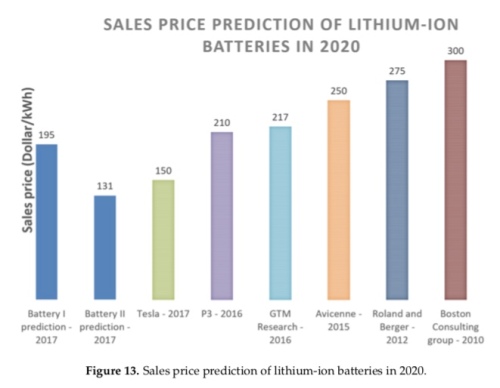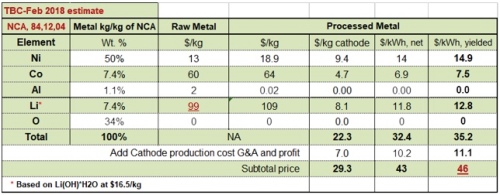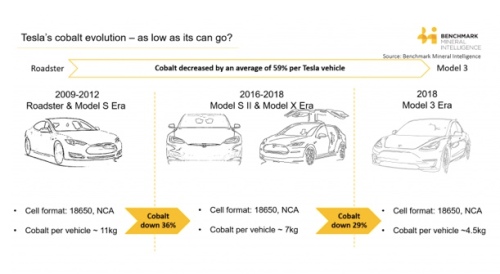As discussed in my last post, the price of an electric vehicle (EV) battery will play a central role in determining EV sales versus internal combustion engine (ICE) vehicle sales through to Tony Seba’s forecast horizon of 2030.
In that post, I also noted that the average sales price of a vehicle in the USA was $36,113 in 2017. Further, I roughly estimated that the cost of an ICE powertrain plus fuel tank was in the order of $3,400 in that year, or roughly 9.5% of the retail sticker price for an average car. Finally, I made the heroic assumption that an EV powertrain without the battery would cost about $1,000. Accordingly, if the powertrain plus battery of an EV is to come down to the cost of an ICE powertrain plus fuel tank, then the battery most come down to $2,400. Is that possible?
To have an EV completely without range anxiety, and given current miles per kilowatt hour (kWh) of battery efficiency, I speculated in another post that a 100 kWh battery would be required. Based on these assumptions, we can back out the target price of the battery (measured per kWh) in order for EVs to match ICE vehicles in price; in other words, $2,400 divided by 100 kWh, or $24 per kWh.
As mentioned in my last post, Bloomberg New Energy Finance (BNEF) estimated that the weighted average cost of an EV battery in 2017 was $209 per kWh. BNEF analysts estimate that this number will come down to $100 by 2023 and Tesla believes that it can hit the $100 number in 2020. But how much lower that $100 per kWh can a battery pack go? Is $24 a possible 12-year target?
Before we get too despondent over hitting the $24 figure, it should be noted that the industry has, in general, been far too pessimist about the speed of cost reductions with respect to battery-pack pricing. The chart below was taken from a September 2017 article titled “Cost Projection of State of the Art Lithium-Ion Batteries for Electric Vehicles Up to 2030” by Berckmans et al in the academic journal Energies. As of 2018, Tesla is already well below $200 per kWh. So those past predictions have turned out far too pessimist.

Nonetheless, while Tesla/Panasonic, the market leaders in battery technology are still securing both technology-driven cost savings and economies-of-scale related cost savings, there are limits as to how far they can go in battery cost reductions.
The most important limiting factor is raw material costs. The table below gives a breakdown of the cathode component alone in a battery pack as provided by Total Battery Consulting’s Dr. Menahem Anderman in a Seeking Alpha article. So the cathode materials alone come to $46 per kWh before we add in the anode, electrolyte, separator and then all the battery management software and hardware required to stop the battery overheating and to maintain the battery’s life.

True, the most costly material used in a Tesla battery is cobalt, and the use of cobalt has been on a declining trend.

Moreover, Elon Musk made this statement in the company’s 2018 Q1 conference call (a Reuters article on this theme can be found here).
“we think we can get the cobalt to almost nothing”
Yet even if we near eliminate cobalt, the lithium and nickel alone will prevent the battery pack price getting anywhere close to $25 per kWh.
More realistically, it may be possible to achieve a $50 per kWh battery sometime after 2025. For a 100 kWh vehicle, $50 per kWh gives a total battery pack cost of $5,000, yet we are trying to seek parity with ICE vehicle pricing by producing a battery pack for around $2,500. What is to be done?
There are two possible solutions. First, a leap in battery chemistry could be achieved such that both energy density (kWh per litre) and specific energy (kWh per kg) jump higher without the need for more raw materials. Solid-state batteries appear the lead contender to become the next generation commercial battery technology some time in the mid-2020s. Apart, from eliminating cobalt, solid-state batteries would boost both energy density and specific energy and, once the technology beds down, these batteries have the potential to push battery costs much lower.
Tony Seba, however, is not looking for a technology breakthrough. A major component of Seba’s EV thesis relates to technology cost curves, and his presentations frequently feature the slide below (for example here). The curve is exponential and shows a 16% decline in costs per annum. Moreover, the technology cost curve is really an amalgam of cost-cutting achieved through economies of scale and through ‘learning by doing’. In short, these are incremental cost savings, not revolutionary cost savings.

For existing lithium ion technology, there are theoretical reasons why both energy density and specific energy cannot go above certain levels that we are fast approaching. Further, while we may be able to eliminate certain battery materials we cannot eliminate all the expensive battery materials. The only way we can stay on this 16% per annum downward-sloping exponential curve is for us to jump into a new generation of battery technology. This may, or may not, happen within Tony’s 2030 forecast horizon, but it is certainly not a given.
OK, let’s assume that we don’t get solid state out of the lab and into the factory in the forecast time horizon and we can’t get battery pack costs down to $25 per kWh. The Tony Seba thesis is that EVs will rule the world by 2030. Should we laugh at that goal? Not quite. It is possible that if we loosen our battery size condition at which range anxiety is eliminated, we may still get there. And one way this could be done is through introducing dynamic charging, or charging in motion.
Currently, the 75 kWh battery in a Model 3 can keep the car on the road for 310 miles. Accordingly, a 50 kWh battery will keep it on the road for around 200 miles. But to eliminate range anxiety, I posited in a previous post that we needed a car to go 450 miles on one charge. One way we can square this particular circle is to charge a car while it is moving, and Qualcomm is developing a dynamic vehicle electric charging (DEVC) system called Halo that does just that.
The Halo system can charge your car at a maximum rate of 22 kilowatts. Therefore, if you travelled over this system for one hour continuously you theoretically could charge your car by 22 kWh. Do that a number of times over a long distance journey, say for 3 hours in total, and that would add 66 kWhs. So now our 50 kWh EV can more than double its range to above 400 miles and bye bye range anxiety. Of course, assuming your EV driver is doing 60 miles per hour, three hours of driving translates into roughly 180 miles, or 290 kilometres. That is considerably longer than the Qualcomm 100 metre DEVC test track. And, of course, we haven’t considered the cost of the required infrastructure.
The other alternative is to bring your car to a stop, but have access to a mega super charger such that an extra 100 miles could be added in minutes. If our 50 kWh Tesla Model 3 can do around 200 miles on one charge, then to add 100 miles you would need a charger to add 25 kWh. A new charger by ABB boasts a charge rate of 350 kW. At that rate, 100 miles could be added in about 5 minutes. Such mega fast charging rates provide further challenges for battery technology, since they have the potential to severely damage a battery if not managed properly. Indeed, no existing EVs on the road could currently cope with such charge rates. Nonetheless, the next generation of high-end German EVs appear to be designed to take advantage of a new generation of super chargers, with Porsche first to market with its Mission E vehicle to be launched in late 2019. Given time, this technology is likely to trickle down to mid- and low-end EV models.
In conclusion, getting the price of a battery down to a point where EVs can blow away ICE vehicles on price is not a given. Indeed, it is very difficult to see how incremental improvements in current battery technology alone can vanquish the internal combustion engine. Nonetheless, it is just possible that the combination of a slightly smaller battery coupled with new charging technology could do the job. At that point, EVs should match or exceed ICE vehicles in every area of the car purchase decision, so setting up the possibility that the market will tip and EV domination was arrive at an unprecedented pace.
Finally, the word ‘unpredicted’ could perhaps substitute for the word ‘unprecedented’ since no mainstream organisation or company is forecasting EV sales to vanquish ICE vehicle sales by 2030. The differing EV sales scenarios will be the subject of my last post in this series.
For those of you coming to this series of posts midway, here is a link to the beginning of the series.

